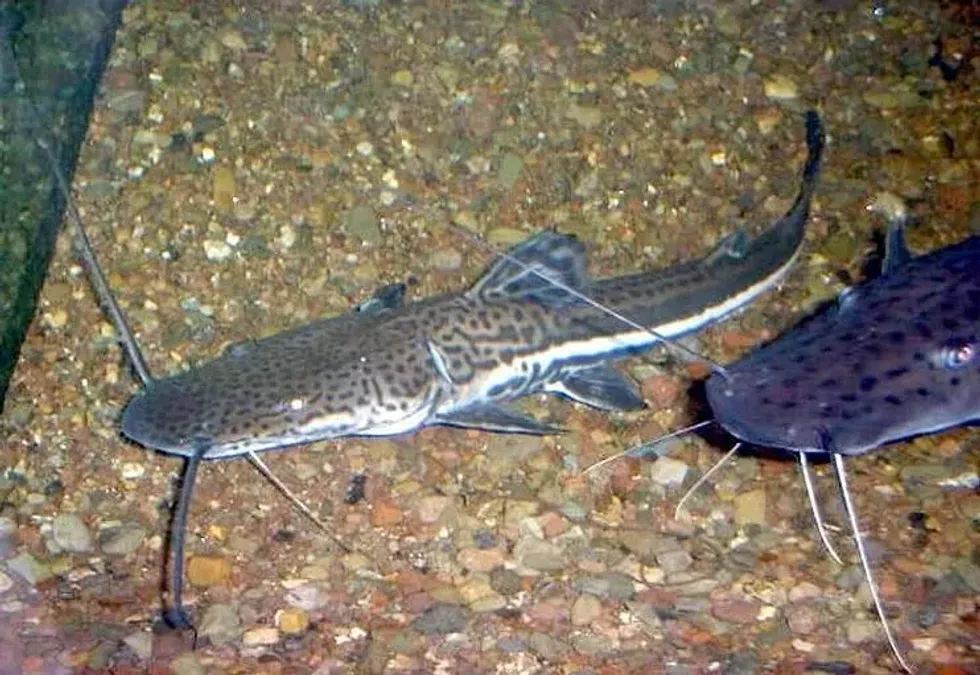Firewood catfish (Sorubimichthys planiceps) are freshwater tropical fishes and are a member of the catfish family Pimelodidae. They have a cylindrical shape, white flattened head, and long large caudal fins.
Adults have a larger upper jaw that transcends the lower jaw, adults usually have broad white stripes extending from the gills to the caudal fins. The appearance of these fish changes as they grow, the young ones do not have the broad white stripes until a certain age is reached by this catfish.
Firewood catfish are the monotypic species of the genus Sorubimichthys which consists of other tropical fishes. They are nocturnal in nature and prefer to spend most of their time during the day hidden under large rocks and logs and come out of their hiding place to search for food during the night.
In aquarium setups, these fish use their large sizes as a means to bully smaller fish.
For more relatable content, check out these channel catfish facts and rainbow trout facts for kids.
Firewood Catfish Interesting Facts
What type of animal is a firewood catfish?
Firewood catfish (Sorubimichthys planiceps) are freshwater fish and are highly predatory in nature feeding on other small fish. It is a type of catfish.
What class of animal does a firewood catfish belong to?
This fish (Sorubimichthys planiceps) belongs to the class of Actinopterygii as they are one of the ray-finned fishes.
How many firewood catfish are there in the world?
Unfortunately, there is no accurate count on the population of these species. Since these species are easily available and are bred in private aquariums, it is impossible to know the exact population.
Where does a firewood catfish live?
Firewood catfish (Sorubimichthys planiceps) are found in the areas nearby whitewater in high suspended sediments of South America.
What is a firewood catfish's habitat?
A firewood catfish's habitat is in the Amazon basin and Orinoco river basins with a high oxygen content in the water.
Who do firewood catfish live with?
Most adults are solitary creatures and like to be alone for most of the time which is different from their larval stage, where they are produced in huge groups and stay together.
How long does a firewood catfish live?
A fully grown firewood catfish (Sorubimichthys planiceps) has a maximum lifespan of 15 years, but with proper care and diet, these species can live longer in an aquarium. Just as other species of fish, its lifespan can be affected by the level of care they receive.
How do they reproduce?
These species reach sexual maturity very late by the age of 14 years old, spawning mostly occurs during the warmer seasons in warm water. They are monogamous in nature and spend the rest of their lives together.
Both males and females swim together releasing the sperm and the eggs in their nest. The incubation period for the eggs is around 10-15 days and both parents take care of the eggs until they hatch.
Males feed the newborn fry until they are big enough to be swimming freely. Soon after, the larvae become independent enough to live their own life.
What is their conservation status?
The conservation status of firewood catfish (Sorubimichthys planiceps) is Not Evaluated under the IUCN Red List. As their population is still unknown due to the aquarium trade, it is not possible for IUCN to put them under any category.
Firewood Catfish Fun Facts
What do firewood catfish look like?
 We've been unable to source an image of a firewood catfish and have used an image of a red tail catfish instead. If you are able to provide us with a royalty-free image of a firewood catfish, we would be happy to credit you. Please contact us at hello@kidadl.com.
We've been unable to source an image of a firewood catfish and have used an image of a red tail catfish instead. If you are able to provide us with a royalty-free image of a firewood catfish, we would be happy to credit you. Please contact us at hello@kidadl.com.Firewood catfish (Sorubimichthys planiceps) are usually large in size and have a cylindrical body with large upper jaws. The size of their head is one-third of their entire body.
The dorsal region of this fish is ash-gray with darker spots covering its entire body.
The sides of these fish have a white band extending from the gills to the tail bordered below with a darker brown band, the dorsal and adipose fins are also spotted. The full adult fin shapes and the color pattern appears once they reach at least 8 in (20 cm) in length.
How cute are they?
These fish are not cute to look at. The presence of big barbels around their mouth and large head makes these specimens odd-looking.
How do they communicate?
It is one of the smart species which are also capable of making different kinds of sounds to communicate with each other. These fish can generate sounds that are classified into two different types based on their stridulation sound, drumming sounds, and processes.
They can also produce a particular sound in the water, based on the vibrations. These species are experts in navigation as they can find their food with the help of their cells and skin which helps them to smell their prey from a long distance.
How big is a firewood catfish?
The body length of a firewood catfish (Sorubimichthys planiceps) ranges from 24-59 in (64-150 cm) in length. They are similar in size to Blue catfish.
How fast can a firewood catfish swim?
Firewood catfish are schooling fish that swim in groups for a large part of their life moving delicately and quickly around the fish tank. These species are fast swimmers and bottom dwellers spend their time hiding under the big rocks and logs.
How much does a firewood catfish weigh?
Firewood catfish grow larger as they grow old, the weight of a fully grown adult can reach up to 35.2 lb (16 kg).
What are the male and female names of the species?
Firewood catfish (Sorubimichthys planiceps) belong to the family Pimelodidae. However, specific names for males and females of the species are not given.
What would you call a baby firewood catfish?
A firewood catfish baby is known as fry.
What do they eat?
These fish are extremely predatory in nature and will eat anything that fits in their mouth. They mostly hunt during the night for small fishes, as they are nocturnal in nature and their diet mostly comprises smaller fishes.
Are they dangerous?
No, this fish is not dangerous at all. Compared to few other additional poisonous catfish species such as the cory catfish.
Would they make a good pet?
Yes, firewood catfish will make an excellent pet as they can easily be accustomed to any environment and it is easy to create an artificial habit for them. Firewood catfish for sale can be easily found online or in pet stores. Firewood catfish prices usually range between $119.99 and $149.99 USD.
These freshwater fish are excellent for beginner aquarists due to their large sizes as they can be easy to spot.
Firewood catfish in aquarium setups are active and fast swimmers and can grow larger in size, due to which they may require a personal large tank, which should be at least 300 gal (1350 l) tank for them as they may like to spend their time adjusting and habituating to their new environment.
These fish prefer running water, so the aquarium tank should have a proper flow of running high oxygen content water with artificial sand and stone beds with driftwoods for hiding. Due to these fish being a standard species in the aquarium population, these species are available in pet stores because of their popularity and ease to raise in captivity.
The presence of a light source in their enclosure may or may not be required as they do not like to be around light sources.
Did you know...
These catfish have several synonyms and some of them are Pteroglanis manni, Sorubim jandia, Platystoma planiceps, Sorubimichthys ortoni, Platystoma spatula, and Sorubimichthys spatula.
These fish can live for 15-18 hours out of water. They can last longer and stay fresh for two to three days if kept in wet conditions.
Firewood catfish are mostly served fried or as a baked delicacy. These fish make great broths and soups as their thick skin prevents the meat from melting during preparation.
This species never stop growing, it is easy to assume their age based on their size.
To protect themselves from predators, camouflage is used by these fish to hide at the bottom of the river, streams, or lakes, under large rocks and logs.
The Mekong giant catfish is the largest catfish in the world.
Are firewood catfish endangered?
No, these fishes are not endangered, though they seem to be vulnerable as these species reach their sexual maturity at the age of 14 years old having a very short period of their last growth spree to reproduce before completing their lifespan.
How did firewood catfish get their name?
Their name was derived from the locals in South America their natural environment due to the lesser eating value of these fishes and frying them to be used as firewood.
Here at Kidadl, we have carefully created lots of interesting family-friendly animal facts for everyone to discover! Learn more about some other fish from our African lungfish facts and channel catfish facts pages.
You can even occupy yourself at home by coloring in one of our free printable quillfish coloring pages.
Second image by Elma.




 We've been unable to source an image of a firewood catfish and have used an image of a red tail catfish instead. If you are able to provide us with a royalty-free image of a firewood catfish, we would be happy to credit you. Please contact us at hello@kidadl.com.
We've been unable to source an image of a firewood catfish and have used an image of a red tail catfish instead. If you are able to provide us with a royalty-free image of a firewood catfish, we would be happy to credit you. Please contact us at hello@kidadl.com.



